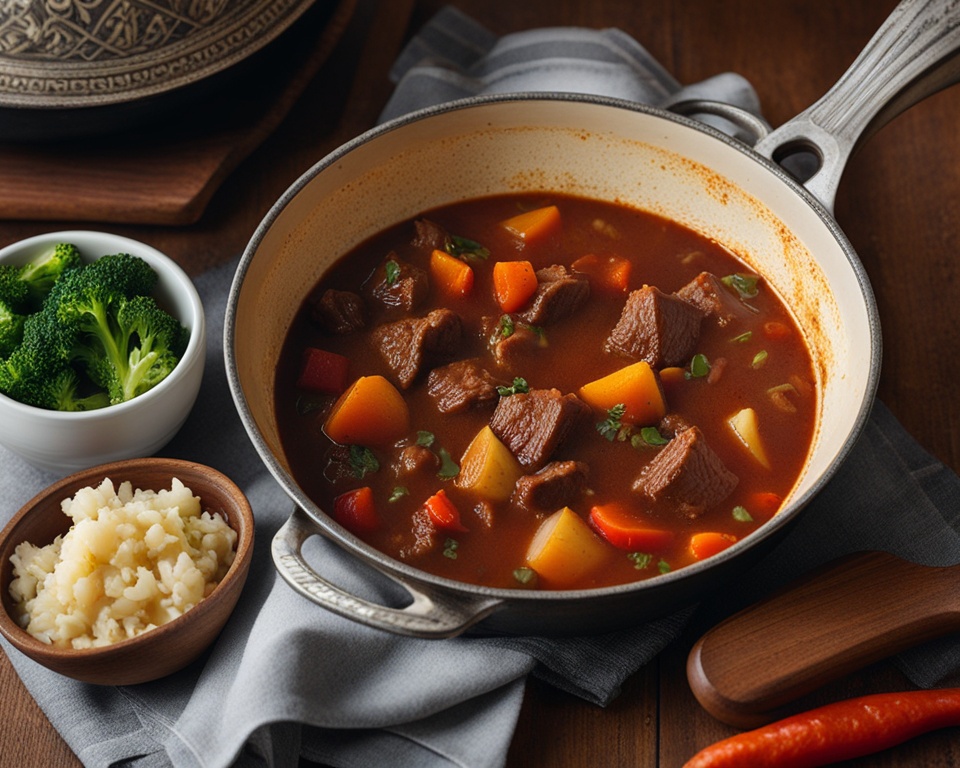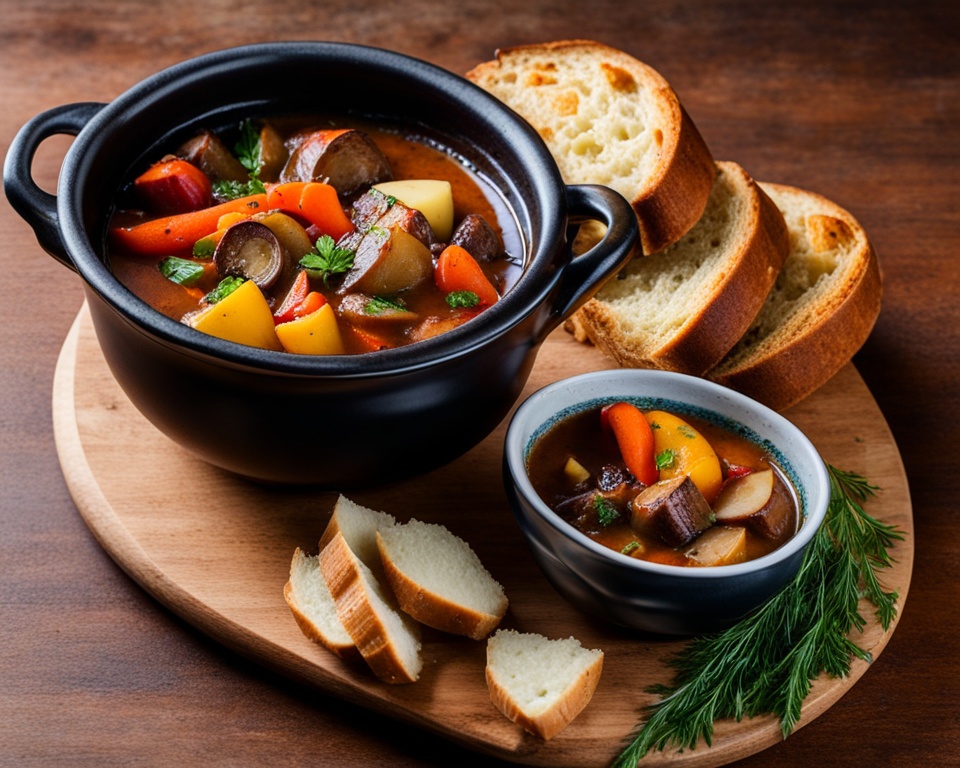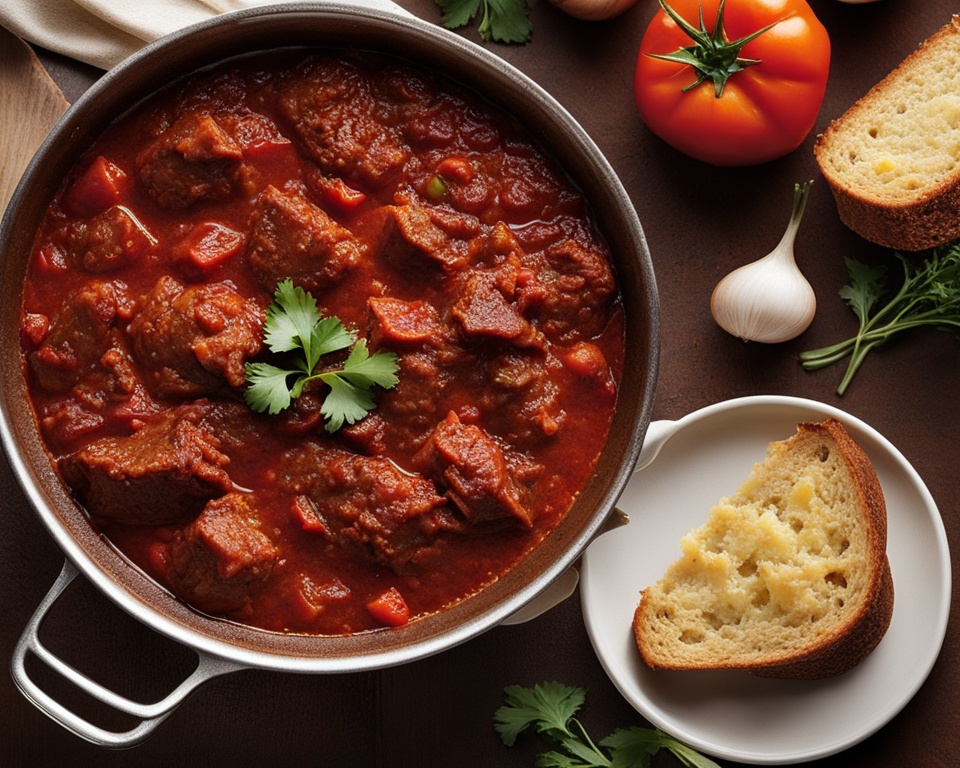Gulasch, also known as goulash, is a favorite in Central Europe. It has won the hearts of people everywhere. This stew comes from Hungary’s shepherds and has a rich history.
It’s a comfort food loved for its mix of tender meat, spices, and vegetables. The dish is known for its savory taste and hearty texture.
Read interesting things at : vsocan
Key Takeaways
- Gulasch is a traditional Central European stew with a long history
- It is made with tender meat, aromatic spices, and hearty vegetables
- Gulasch has become a beloved comfort food around the world
- The dish originated from Hungarian shepherds and has evolved over time
- Gulasch is known for its rich, savory flavors and satisfying texture
Origins and History of Gulasch
The traditional Central European stew, gulasch, has its roots in Hungarian shepherds’ and herdsmen’s food. These nomadic people made a portable meal with meat, onions, and spices as they moved across the Pannonian Basin. This traditional Hungarian stew grew and changed, picking up flavors from nearby areas. It became a favorite dish in Hungary.
Gulasch spread across Central Europe, changing but keeping its core taste. The evolution of the gulasch recipe shows the region’s lively food history. Today, people all over the world enjoy gulasch, but it’s still a key part of Hungarian culture.
The Evolution of a Classic Dish
Back in the 9th century, Magyar herdsmen made a simple stew with meat, onions, and spices. This dish moved through the Pannonian Basin, picking up new tastes. This is how the history of goulash began.
- In the 16th century, paprika was added to gulasch, coming from the Americas.
- By the 18th and 19th centuries, gulasch was a common meal in Hungarian homes, with recipes passed down through families.
- Gulasch became popular in the Austro-Hungarian Empire, leading to local versions in Austria, Croatia, Serbia, and other places.
Today, gulasch is still a cherished traditional Hungarian stew, loved for its rich taste and warm feel. The evolution of gulasch recipe keeps going, with chefs and cooks finding new ways to make this classic dish.
“Gulasch is more than just a stew – it’s a testament to the rich culinary heritage of Central Europe, a dish that has endured and evolved over centuries.”
What is Gulasch?
Gulasch, also known as goulash, is a hearty stew from Central Europe. It’s famous for its rich taste and ability to warm you up on cold days.
Gulasch is a thick, slow-cooked stew. It has tender beef or other meats in a flavorful broth. The broth is seasoned with spices, especially paprika. The stew gets thickened with a roux or bread cubes, making it smooth and different from other stews.
The definition of goulash is a hearty, tasty stew. It highlights the rich flavors of Central European cooking. The description of gulasch makes you feel warm, nourished, and reminds you of home-cooked meals.
| Characteristic | Description |
|---|---|
| Main Ingredient | Beef or other meats, such as pork or veal |
| Seasoning | Paprika, onions, garlic, and other aromatic spices |
| Texture | Thick, velvety, and slow-cooked to perfection |
| Origin | Central Europe, particularly Hungary and Austria |
What is gulasch is a dish that shows off Central Europe’s rich cooking traditions and tastes. It’s perfect as a main dish or part of a big feast.
“Gulasch is the ultimate comfort food – a hearty, satisfying stew that warms the soul and brings people together around the table.”
The Gulasch: A Hearty Central European Stew
The central european stew known as gulasch is loved across the region. It’s famous for its deep, savory flavors and comforting texture. This hearty gulasch has tender beef or other meats. They simmer slowly in a broth full of spices like paprika, caraway seeds, and bay leaves.
The stew’s rich, velvety texture is great with crusty bread or creamy mashed potatoes. The savory flavors of gulasch and its comforting texture of goulash make it a true comfort food. It warms the soul on cold days.
Savory Flavors and Comforting Textures
The central european stew is all about the right mix of spices and seasonings. Paprika gives it a vibrant color and a bit of heat. Caraway seeds add an earthy, aromatic touch. The meat soaks up the savory flavors of gulasch, creating a perfect blend of textures and tastes.
Slow-simmering is key to getting the comforting texture of goulash. It breaks down the meat’s connective tissues and blends the flavors together. This makes the stew rich, velvety, and very satisfying. It’s a key dish in Central European cuisine.
“Gulasch is a dish that nourishes both the body and the soul, with its comforting flavors and heartwarming embrace.”
Traditional Gulasch Ingredients
A classic gulasch is made with a special mix of ingredients. These traditional gulasch ingredients have stayed the same over time. They are the key to the dish’s unique taste.
Essential Elements for Authentic Flavor
The heart of a true authentic gulasch recipe is the mix of tender meat, fresh veggies, and spices. A traditional gulasch includes:
- Beef (or a mix of meats like pork and veal)
- Onions, for their natural sweetness
- Paprika, which adds a smoky-spicy taste
- Garlic, for depth and complexity
- Broth, to make a rich, tasty base
These essential elements of gulasch blend together perfectly. The tender meat and sweet onions are balanced by the paprika’s bold flavor.
| Ingredient | Role in Gulasch |
|---|---|
| Beef | Provides the foundation of the dish, lending a hearty, satisfying texture |
| Onions | Contribute natural sweetness and aroma, balancing the savory elements |
| Paprika | Imparts the signature smoky-spicy flavor that is characteristic of gulasch |
| Garlic | Adds depth and complexity to the overall flavor profile |
| Broth | Creates a rich, flavorful base that ties all the ingredients together |
These traditional gulasch ingredients and their roles make the dish taste and feel authentic.
Regional Variations of Gulasch
The core ingredients and cooking method of gulasch stay the same, but it changes to fit the tastes of different regions in Central Europe. These changes show how this comfort food has grown and stayed popular over time.
In Hungary, gulasch gets a lot of paprika, making it a deep red stew with a strong, smoky taste. This version is thicker and more filling than others.
In Austria, gulasch might have more veggies like potatoes and carrots. This makes the dish more about the vegetables. The Austrian gulasch is known for being richer and more like a stew.
In Germany, gulasch can be thickened with bread or flour. This makes it even thicker and more like a stew. It shows how the dish can change to fit local tastes and traditions.
These different takes on gulasch show how the dish can change while keeping its core identity. Whether you like the Hungarian style with lots of paprika or the Austrian version with more veggies, gulasch from Central Europe offers many flavors to try.
Cooking Methods for Gulasch
When it comes to cooking methods for gulasch, slow-cooking is key. This rich stew from Central Europe needs patience and care. But, the result is totally worth it. Let’s dive into the secrets of slow-cooked gulasch.
Slow-Cooked Perfection
The traditional way to make gulasch involves several steps. First, the meat gets browned to create a deep crust. This step adds a unique flavor to the dish.
After browning, the meat simmers in a flavorful broth for hours. This breaks down tough parts, making the meat tender.
Many cooking methods for gulasch suggest cooking over an open fire. This adds a smoky taste to the dish. Whether cooked on the stovetop or in a slow cooker, slow-cooking is key. It brings out the true taste of gulasch. The end result is a rich, comforting stew that’s perfect after a long wait.
| Cooking Method | Time | Flavor Profile |
|---|---|---|
| Stovetop Simmering | 2-3 hours | Robust, Caramelized |
| Slow Cooker | 6-8 hours | Deeply Developed, Tender |
| Open Fire | 3-4 hours | Smoky, Rustic |

“The secret to a truly exceptional gulasch lies in the patient, slow-cooking process that allows the flavors to meld and the meat to become incredibly tender.”
Serving and Pairing Gulasch
Gulasch, a hearty stew from Central Europe, is a main course. It’s best with sides that bring out its rich flavors. Creamy mashed potatoes and buttered egg noodles are top choices. They balance the stew’s bold taste.
A simple green salad can also be a refreshing side. Or, serve the gulasch over steamed rice or with crusty bread. This is great for dipping into the flavorful sauce.
For drinks, a full-bodied red wine or a crisp lager are perfect. The wine’s bold flavors match the stew’s taste. The lager’s fizz cleanses your palate between bites.
| Side Dish | Beverage Pairing |
|---|---|
| Creamy Mashed Potatoes | Full-Bodied Red Wine |
| Buttered Egg Noodles | Crisp Lager |
| Simple Green Salad | Dry White Wine |
| Steamed Rice | Pale Ale |
| Crusty Bread | Dark Beer |
Choosing the right sides and drinks makes dining with gulasch enjoyable. It highlights the stew’s flavors and textures.
Nutrition and Health Benefits of Gulasch
Gulasch, a favorite in Central Europe, is more than just tasty. It’s also packed with nutrients. Made with beef or other meats, it’s a great source of lean protein. This protein is key for keeping muscles strong and supporting health.
A Hearty and Satisfying Meal
This dish is full of vitamins and minerals from veggies like onions and bell peppers. These give you vitamins A and C. The long cooking time also makes the meat’s nutrients easier for your body to use. When eaten in moderation, gulasch can be a filling and healthy part of your meals.
| Nutrient | Amount per Serving | % of Daily Value |
|---|---|---|
| Calories | 350 kcal | 18% |
| Protein | 30 g | 60% |
| Fat | 15 g | 23% |
| Carbohydrates | 20 g | 7% |
| Vitamin A | 20% DV | 20% |
| Vitamin C | 30% DV | 50% |
| Iron | 15% DV | 15% |
The table shows the nutrition of gulasch, highlighting its health benefits and nutritional value. It’s clear that gulasch is a balanced and wholesome choice for those looking to eat healthily.
Gulasch in Hungarian Culture
In Hungary, gulasch is more than a favorite dish. It’s a cultural icon and a symbol of national pride. This savory stew has been a key part of Hungarian food for centuries. Recipes and techniques have been passed down through generations.
Gulasch is often seen as a sign of Hungarian hospitality. It’s served at special events, family get-togethers, and community gatherings. The dish’s rich flavors and comforting nature are deeply rooted in Hungarian culinary traditions.
This makes gulasch a key part of the Hungarian identity. Hungarians are very careful with the stew’s preparation and traditional methods. They take great pride in it.
Gulasch also has a big role in Hungarian culture. It brings people together, sharing stories and celebrating their heritage. The dish is a unifying force.
“Gulasch is not just a meal, it’s a tradition that connects generations and brings our community together.”
The role of gulasch in Hungary goes beyond the kitchen. It’s a source of national pride and shows the country’s culinary identity. Hungarians are passionate about keeping its authenticity and traditional ways of making it.
Gulasch is a cherished part of Hungarian life, whether at family dinners or community events. It’s a culinary tradition that keeps people connected and celebrates Hungary’s rich culture.
Modern Twists on Classic Gulasch
The traditional gulasch recipe is still a favorite, but chefs and home cooks love to add their own twist. These new takes show how this Central European dish can change and stay loved.
Innovative Takes on a Beloved Dish
Some modern gulasch recipes use different meats like lamb or bison for a fresh taste. Others add ingredients like beer or chocolate for more flavor. These innovative goulash dishes prove the dish can change to fit new tastes.
Now, there are also vegetarian and vegan versions of modern gulasch recipes. These creative twists on traditional gulasch show the dish can reach more people, not just meat lovers.
“The beauty of gulasch lies in its ability to evolve and surprise. These modern interpretations reinvent a classic, while staying true to its comforting roots.”
Chefs and home cooks keep trying new things with gulasch. This shows how much people love it and how it can keep changing.
Gulasch: A Taste of Central Europe
Gulasch is a key dish in Central European cuisine. It takes you on a journey through the continent’s heart. From Hungary’s paprika-rich bowls to Austria and Germany’s veggie-packed versions, it shows the region’s rich culture and traditions.
Trying gulasch is like diving deep into Central European cuisine. Every bite tells a story of shared history and flavors. It’s a mix of tastes that go beyond borders.
In a cozy Gasthaus in Vienna or a busy market in Budapest, goulash takes you straight to Central Europe‘s core. Its slow-cooked goodness and mix of spices wake up your senses. It brings to mind the region’s famous warmth and hospitality.
“Gulasch is not just a dish; it’s a cultural touchstone that connects the diverse tapestry of Central Europe.”
Gulasch links the Carpathian Mountains to the Bavarian hills, uniting the region’s diverse nations and communities. Eating this stew is like going on a food adventure. Each spoonful reveals the flavors and traditions of Central European cuisine.
| Country | Signature Gulasch Variation | Key Ingredients |
|---|---|---|
| Hungary | Hungarian Goulash | Beef, onions, paprika, tomatoes, bell peppers |
| Austria | Viennese Gulasch | Beef, onions, carrots, celery, paprika, caraway seeds |
| Germany | Bavarian Gulasch | Beef, onions, tomatoes, potatoes, beer, mustard |
If you’re experiencing gulasch for the first time or discovering goulash in Central Europe, it’s a culinary journey. Each spoonful takes you through the heart of Central Europe. Enjoy the flavors and let them take you on a delicious trip.
Tips for Perfecting Your Gulasch
Making the perfect gulasch takes a few key steps. Start with high-quality, well-marbled beef that gets tender during cooking. It’s important to brown the meat well. This step creates a rich, caramelized flavor.
Getting the spices right is crucial for that authentic gulasch taste. Use the right mix of paprika, caraway seeds, and garlic. Let the stew simmer slowly, stirring now and then. This patience makes the dish smooth and flavorful.
Secrets to a Flavorful Stew
Here are some tips for the best gulasch:
- Use high-quality, well-marbled beef for maximum tenderness
- Thoroughly brown the meat to develop a rich, caramelized flavor
- Carefully balance the spices, with the right amount of paprika, caraway, and garlic
- Allow the stew to simmer slowly, stirring occasionally, for a velvety-smooth texture
| Ingredient | Importance |
|---|---|
| Beef | High-quality, well-marbled beef is essential for tender, flavorful gulasch |
| Spices | The right balance of paprika, caraway, and garlic is crucial for authentic gulasch taste |
| Simmering | Slow, gentle simmering is the secret to a velvety-smooth, flavorful stew |
Follow these tips to make the best gulasch at home. This beloved Central European dish will be a hit with your family and friends.
“The secret to a perfect gulasch is in the details. From the quality of the beef to the balance of spices, every step is crucial for achieving that rich, comforting flavor.”
Vegetarian and Vegan Gulasch Alternatives
More people are choosing plant-based diets, so there’s a big demand for tasty vegetarian and vegan dishes. Gulasch, a popular stew from Central Europe, is getting a plant-based makeover. Now, vegetarian gulasch and vegan goulash recipes are available for those who follow these diets.
These versions use vegetables like mushrooms, lentils, or soy-based proteins to mimic the original dish’s texture. The secret to great plant-based gulasch recipes is in the spices. Chefs use smoked paprika, caraway seeds, and other spices to get that rich flavor.
Thanks to vegetarian gulasch and vegan goulash, everyone can enjoy this warm, comforting dish. These dishes are a great way for all to taste the essence of gulasch. They make the dish inclusive and accessible to more people.
| Ingredient | Vegetarian Gulasch | Vegan Goulash |
|---|---|---|
| Protein | Mushrooms, Lentils | Soy-based meat alternatives |
| Spices | Smoked paprika, Caraway seeds | Smoked paprika, Caraway seeds |
| Vegetables | Onions, Peppers, Potatoes | Onions, Peppers, Potatoes |
| Broth | Vegetable broth | Vegetable broth |
The table shows the main differences in ingredients between vegetarian gulasch and vegan goulash. It proves that plant-based versions can still capture the traditional dish’s essence.

“Embracing plant-based versions of beloved dishes like gulasch allows us to enjoy the comforts of traditional cuisine while catering to diverse dietary needs and preferences.”
Conclusion
Gulasch, a beloved dish from Central Europe, has a long history. It started as a simple meal for Hungarian shepherds. Now, it’s loved worldwide as a comfort food.
This stew is known for its rich flavors, tender meat, and cozy texture. It’s a key part of Central European culture. People enjoy it in its traditional way or with new twists.
Thinking about gulasch makes us appreciate its history and lasting appeal. From its roots to modern takes, gulasch stands out in Central European cuisine. It’s a symbol of the region’s rich food culture.


